Most of you that have met me in person, know that I am not a real theoretical person and for me frameworks are only as good as your ability to implement them. For me in the world of gamification, there are an awful lot of evangelists and theory creators and very few implementors. As a company and individual mainly focused on implementing it is more vital that a project works for a client rather than to stick with theory and force-fitting it to everything, which does happen even when these frameworks are based on sound principles. So my health warning for all frameworks is to base your practise on it if it fits the purpose of the client and their target audience. Keep a flexibility perspective on how you apply it.
In learning related gamification there are some misconceptions about what gamification actually means and where it applies. For quite a lot of providers, it is about adding points, badges and leaderboards, under the assumption that all learners are looking for a bit of competition and that this will stimulate them to learn more. Unfortunately this is a rather simplistic view. Most learners have a plethora of reasons of why they learn. The key is to understand these and design to satisfy the learner preferences in the first instance.
It is out of the frustration of seeing gamification implemented really badly in learning and development that I came up with the 3 Levels of Learning Gamification Framework. Before you enter the realm of learning gamification however you need to start with solid gamification design. In my view it looks like the image below and in my view none of the steps are negotiable for skipping, especially not the middle step.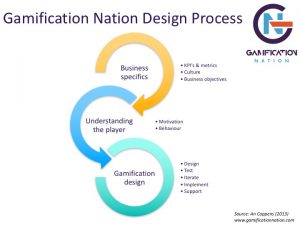
Once you are clear about business specifics and that you have a good understanding of your learner and their motivations, then the 3 Levels of Learning Gamification Framework becomes applicable.
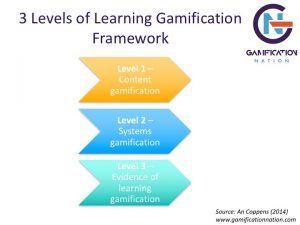
The reason why I have broken it down into 3 levels is because in the early days of gamification it seemed that learning management system providers claimed to be fully gamified when they had added some game mechanics in their system. Whilst it has a place, it is not the starting point. The starting point for learning related gamification is all about the content.
If you think back to your early years, most of the learning you did happened through exploration and feedback of whether it worked or not. It is still a default learning setting for a lot of learners to want to be in charge of how, when and which way they learn best. Some great work was done by the Institute of Play, who created a quest based learning lesson plan and even curriculum plans. I am a big advocate of this method of presenting content and letting the learner choose to opt in.
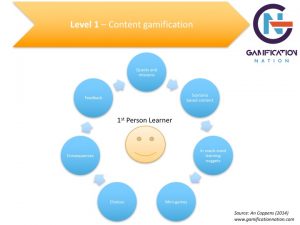
The key in content gamification is to always make the learner feel like he or she is in charge. That they have choices and those choices lead to some consequences. Consequences can be positive reinforcement or feedback that you weren’t successful. Most people have learned their biggest lessons from doing things wrong and taking on-board the lesson. Very often when we get something right first time it is hard to replicate and what worked once may not actually work again.
Level 2 learning gamification design is all about providing a system for the learner to progress in. Typically, you would find progression towards mastery as a core component. It is here a lot of assumptions are made about competition and encouragement.
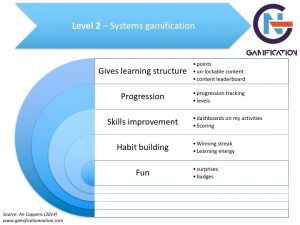
A lot of people believe competition is healthy, I would argue that in the learning environment it is only a positive experience for those at the top of the league table. Personally, I would rather be given the choice to have my learning publicly displayed or not. From the feedback I keep receiving in my work with learners in the corporate sector, I am part of a vast majority of learners, who would rather learn privately and once they mastered a skill display it publicly.
We all have a different pace of learning and also different ways that appeal to our appetite. What most of us do want is to know we are achieving progress, progress towards mastering a skill may mean an element of practise. The daily streak in Duolingo for logging in and taking lessons every day is a good example of this habit building practise for language learning. They make no excuses that to improve you need to practise regularly. As a person with multi-lingual skills, I can only agree that regular immersion will improve your ability no end.
The fun aspects in this level can be badges used as fun confetti with funny slogans or reward statements, surprises which help you boost your power or energy, may make a difference. For the corporate sector it is key to keep it in line with your corporate messaging and even some of the rituals you already have in place or if you have great characters, they can add some insider fun.
Finally the 3rd level of learning gamification is where proof of mastery is involved. I was the first to bring this element to the learning gamification equation, because ultimately that is the purpose of learning in my view. Earlier frameworks mentioned level 1 and 2, but didn’t venture into the realm of looking for proof. In a lot of cases, an end of course quiz or exam is proof. Whilst those have a place in the academic world, in the corporate sector having skills that can be put into action are probably more important. In my work in employee engagement, we often have the request to create competency proofing as part of the recruitment process, which can be achieved through means of hack challenges or similar quest like recruitment methods.
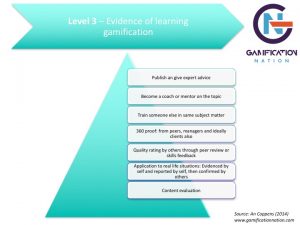
The first instance of evidence of learning starts at being able to rate the content and assign a level to it. All learners after completion will be able to say how relevant something was and how steep the learning curve was for them. You may need to give guidance as to how you describe basic, intermediate or advanced, but most of us will be able to come close in our assessment of materials. Ratings will average out to a level with larger numbers of evaluation taking place.
The next piece of proof is a learner explaining how he has applied the new knowledge or skill and ideally an element of proof of others to verify this is definitely the case. Feedback on the quality of skill will give further improvement feedback to the individual.
360 degree feedback happens where various levels of people around the learner can vouch that they have indeed mastered the skill they were acquiring. 3rd party evidence tends to be more weighted than immediate peers or fellow course participants. The final parts of proof of learning are delivering training in the subject, passing on what you have learned to other people. Mentoring or coaching others in the area are next. Finally publishing expertise or giving expertise freely based on the tacit understanding that this individual has reached such a level of competence, where peers are looking for input and advice on the matter.
I hope that in this post,I have given you some insight into the frameworks I work with for my clients. As said at the beginning, a framework is only as good as it’s implementation into practise. I know it took me a few turns before I was a master of my own methods, so for those of you embarking on the same track feel free to ask for assistance and either way learn from feedback.




